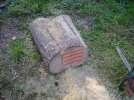Cdent made a good point about rocks. When we cut up stump material we always will end up hitting rocks. If you have a mill cut the stump you will have to pay for a blade each time you hit a rock which is bound to happen. Here is how to do it yourself.
After you pull the stump, trim away as much of the roots as you can with your chainsaw. With a pressure washer blast away all the dirt and bark paying special attention to the underside to make sure there are no dirt or rocks in any of the gaps. Paint the cut end of the stump to seal the end grain to control some of the cracking. If you won't be cutting the stump into slabs right away, throw a tarp over the stump. Do not leave it in direct sunlight.
When you cut the stump into slabs;
If you cut across the stump (crosscut) you will get about 10 times as much cracks and waste.
Best way is to cut the wood vertically (from top of stump down toward roots) for the best stability,
Make your first cut splitting the stump in half. This way you get a good idea what is inside the stump and if it is worth going further. As you come across rocks bust them out with a hammer and prybar or strong steel chisel. Any time you cut a rock you will need to re-sharpen the saw. Don't be tempted to keep cutting with a dull saw. It makes more work than it is worth. Quicker to re-sharpen. After it is split and the wood looks pretty clean you can cut slabs with your chainsaw parallel to the cut you just made. Probably should keep the slabs 2&1/2" thick or thicker.
After you cut the slabs, stack them off the ground with 1x2s for stickers between the slabs. This allows air flow between the slabs for drying. Keep the wood out of direct sunlight or you will get tons of surface checking (cracks). A tarp will protect the wood from the weather. Normal air drying time is about 1 inch per year.
After you have done all this you have 2 choices.
1. Let the wood air dry abour 2 or 3 years.
2. Let it air dry a few months and then find someone with a kiln who will finish the drying for you in their kiln. By letting it air dry a while before going into a kiln a lot of the moisture has gone away so the wood won't move as much when it goes into the kiln. (less waste)
I hope this helps some.


